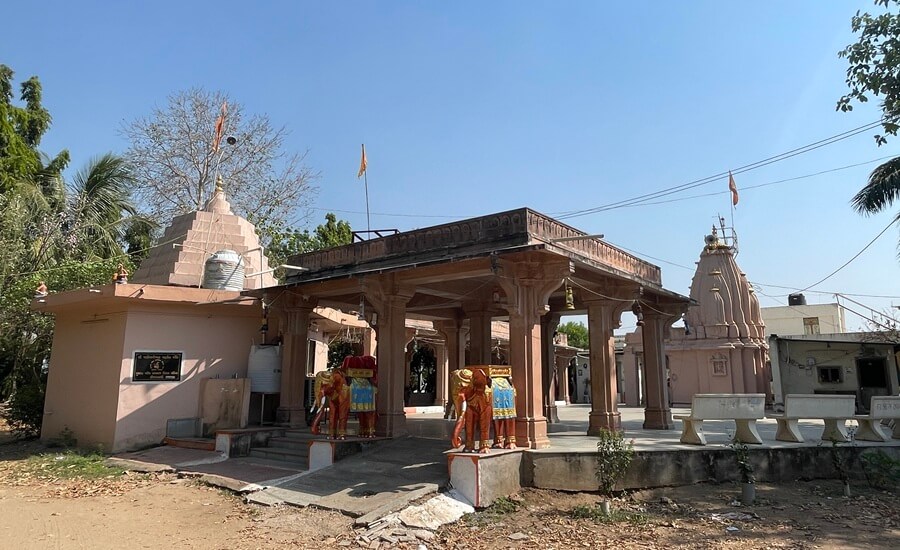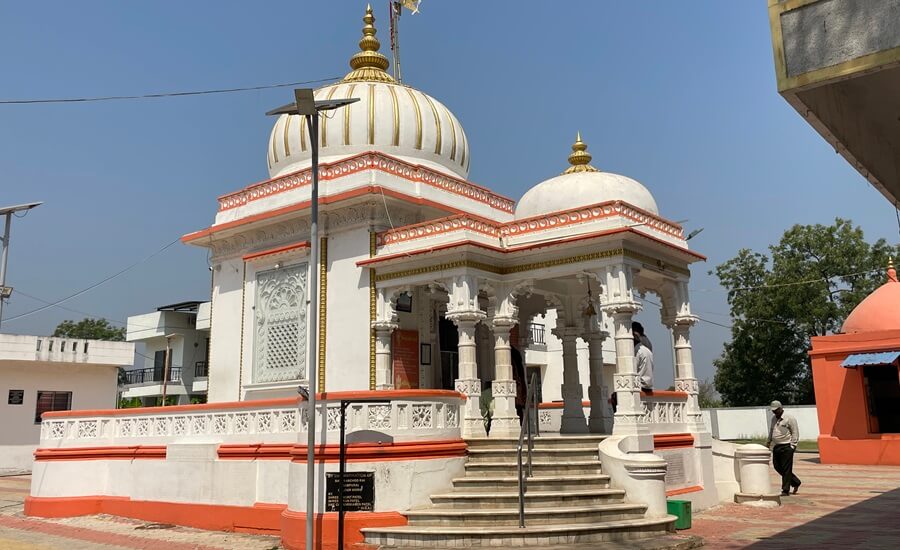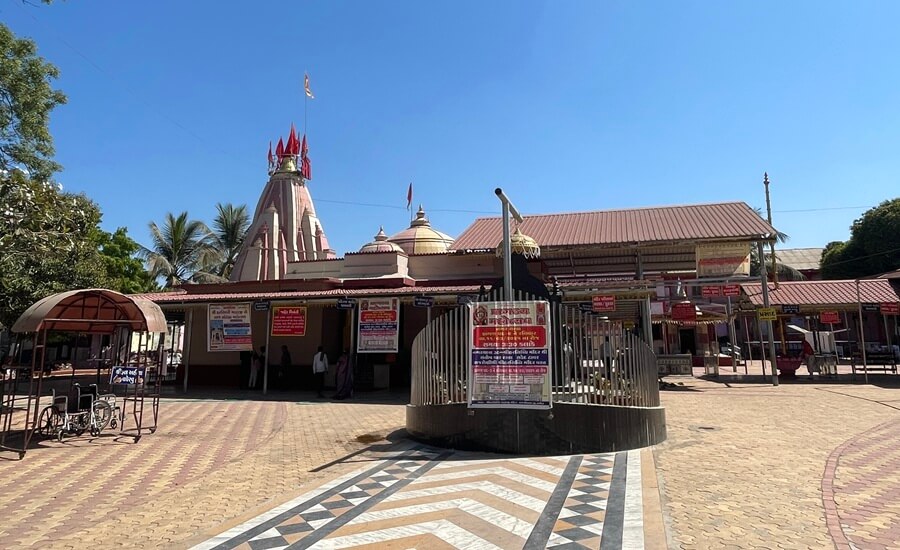

The temple of Harsiddhi Mata, who is renowned in the Puranas, is located in Rajpipla, Gujarat, and is believed to have been brought here from the city of Ujjain of the legendary king Vikramaditya. This temple was built in the 18th century. Devotees strongly believe that the goddess residing in this ancient temple is awakened (Jagrut). She is reputed never to send back empty-handed any devotee who bows before her. Couples, who sincerely worship the goddess are believed to be blessed with children. Therefore, devotees visit the temple throughout the year, with the crowd significantly increasing during the Navratri festival.
Several legends are associated with the goddess. One of the most famous stories involves King Daksha, the father of Sati, who once conducted a grand yajna (ritual sacrifice) inviting all gods and goddesses except Shiv and Sati. Sati attended the event despite the insult and felt humiliated when Daksha disparaged Shiv. Outraged, she immolated herself in the yajna fire. A grief-stricken Shiv wandered the universe carrying her body, causing chaos in the cosmos. According to Vaishnav Puranas, the gods requested Lord Vishnu’s intervention, who then used his Sudarshan Chakra to dismember Sati’s corpse. Each place on earth where her body parts fell became revered as a Shakti Peeth. Her elbow fell in Ujjain, making it a significant Shakti Peeth. 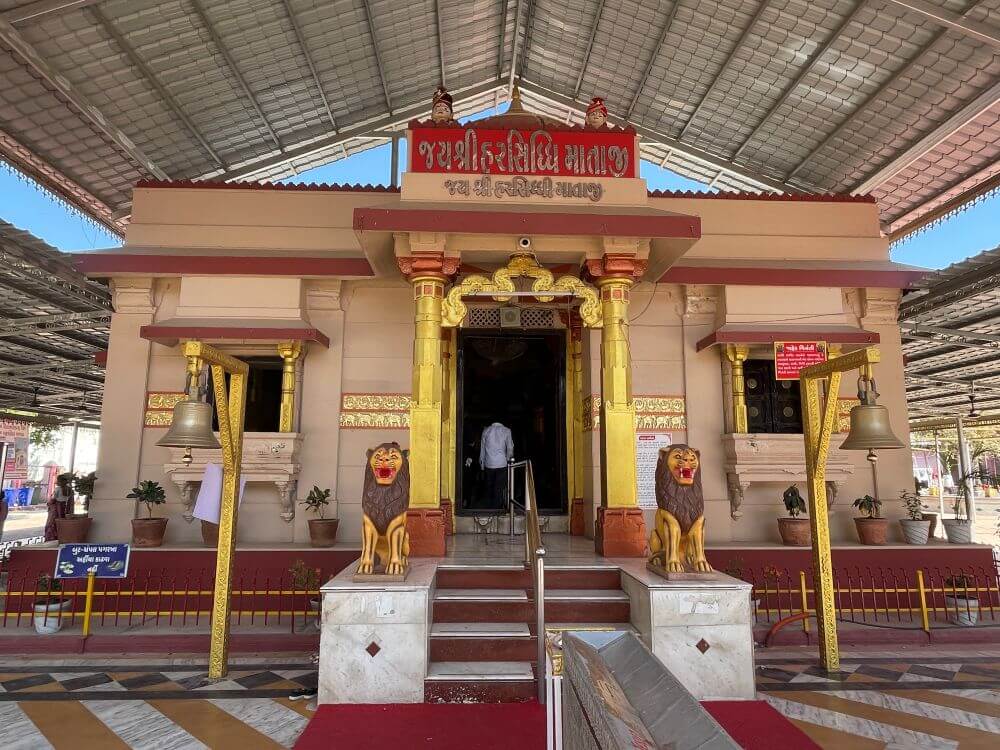 The goddess of this temple in Rajpipla is the same deity from Ujjain.
The goddess of this temple in Rajpipla is the same deity from Ujjain.
This goddess is revered by Lord Krishna and the Yadav dynasty. According to the Sabha Parva of the Mahabharata, At Lord Krishna’s instruction, Bhima killed Jarasandha by tearing him into two pieces. According to the Puranic legend, with the blessings of this goddess, believed to be a form of Mangalmoorti Devi, Shri Krishna was able to successfully bring about the slaying of Jarasandha. Therefore, the Yadavas named this goddess ‘Harsiddhi’.
Originally known as ‘Mangal Chandi,’ the goddess was the family deity of Emperor Vikramaditya of Ujjain. Vikramaditya was so devoted that he offered his head to the goddess eleven times, which she miraculously restored each time.  On the twelfth attempt, however, it was not restored, resulting in his death.
On the twelfth attempt, however, it was not restored, resulting in his death.
Historical accounts suggest the deity arrived in Gujarat from Ujjain in the 14th century. Chokrana, a Rajput prince from the Parmar dynasty of Ujjain, came to Gujarat, establishing his kingdom with Nandipur (present-day Nandod) as the capital. Later, he moved his capital to Rajpipla. His daughter married into the Gohil Rajput dynasty. After Chokrana’s death, his grandson Samarsinh, from the Gohil dynasty, ascended the throne. The Gohil Rajputs adopted Harsiddhi Mata as their family deity.
It is said that, in 1705, Maharana Verisal I visited the original temple of Harsiddhi Mata in Ujjain and subsequently defeated Mughal forces sent by Aurangzeb with the help of Maratha Sardar Damaji Jadhav.  Following this victory, he brought back an idol of the Goddess from Ujjain and installed it in Rajpipla. The temple was entrusted to the Gujarat government in 1950 and has since been renovated.
Following this victory, he brought back an idol of the Goddess from Ujjain and installed it in Rajpipla. The temple was entrusted to the Gujarat government in 1950 and has since been renovated.
Rajpipla serves as a central location in Narmada District of Gujarat. During its history under Gurjar rule, it was known as “Nandipuri” and later referred to as “Nandol” or “Nandod” during medieval times. This ancient temple remains one of the most renowned temples in Gujarat. In front of the temple stands a grand gateway (Nagarkhana). Upon entering through its arched entrance, visitors find a spacious courtyard featuring a statue of Maharana Verisal I on a throne alongside an inscription detailing the temple’s history. This statue was erected in 2021. 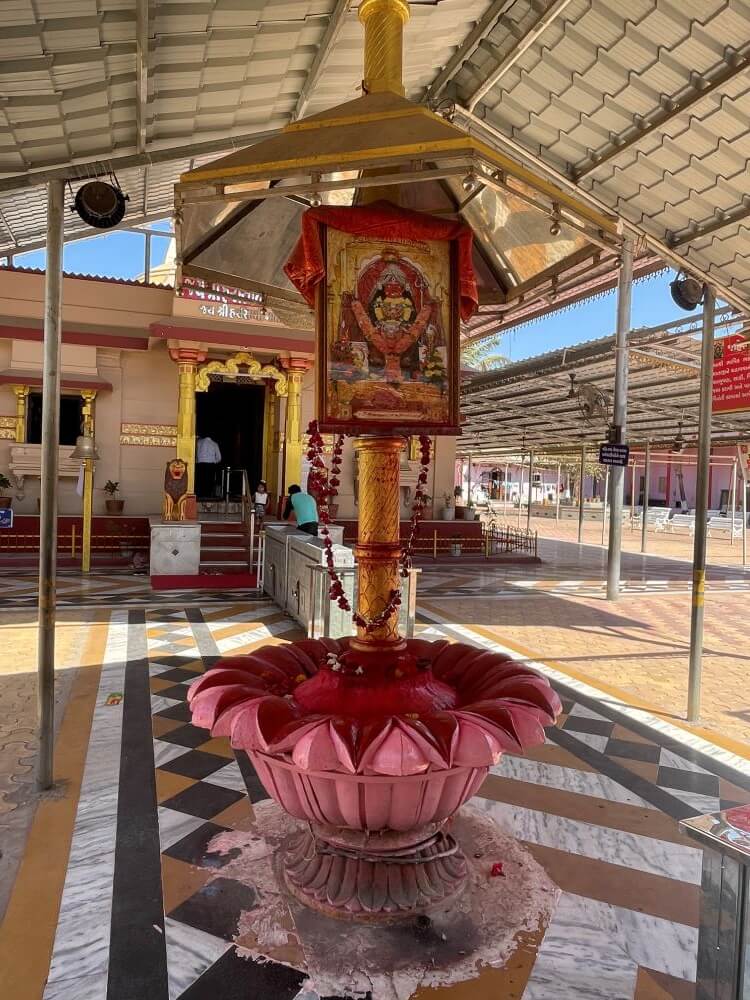 The courtyard also contains temples dedicated to Surya Dev and Omkareshwar Mahadev.
The courtyard also contains temples dedicated to Surya Dev and Omkareshwar Mahadev.
In front of the temple is a sacrificial fire pit (Homkund), and nearby stands a tall brass Shakti pillar (Shaktistambha). This pillar was initially erected during the temple’s original construction. Over time, as the pillar became worn, it was replaced with a new one. At the base of the pillar, there is a lotus-petal platform, and slightly above it, an image of the goddess is installed. Devotees worship the goddess at this pillar before entering the temple.
The temple features modern architecture and consists of an entrance porch (Mukhamandap), an assembly hall (Sabhamandap), and a sanctum (Garbhagriha). The entrance porch and assembly hall have dome-shaped subsidiary spires, while the sanctum has an Urushrung style spire. The temple is built on a high platform, and visitors ascend a few steps to enter the entrance porch, where lion statues are placed on either side of the entrance.
The assembly hall of the temple is spacious, adorned with golden circular decorations that enhance its beauty. The sanctum (Garbhagriha) is directly ahead. On the left side of the sanctum’s entrance wall, there is a shrine housing an idol of Ganesha, while on the right side, there is an idol of Hanuman. 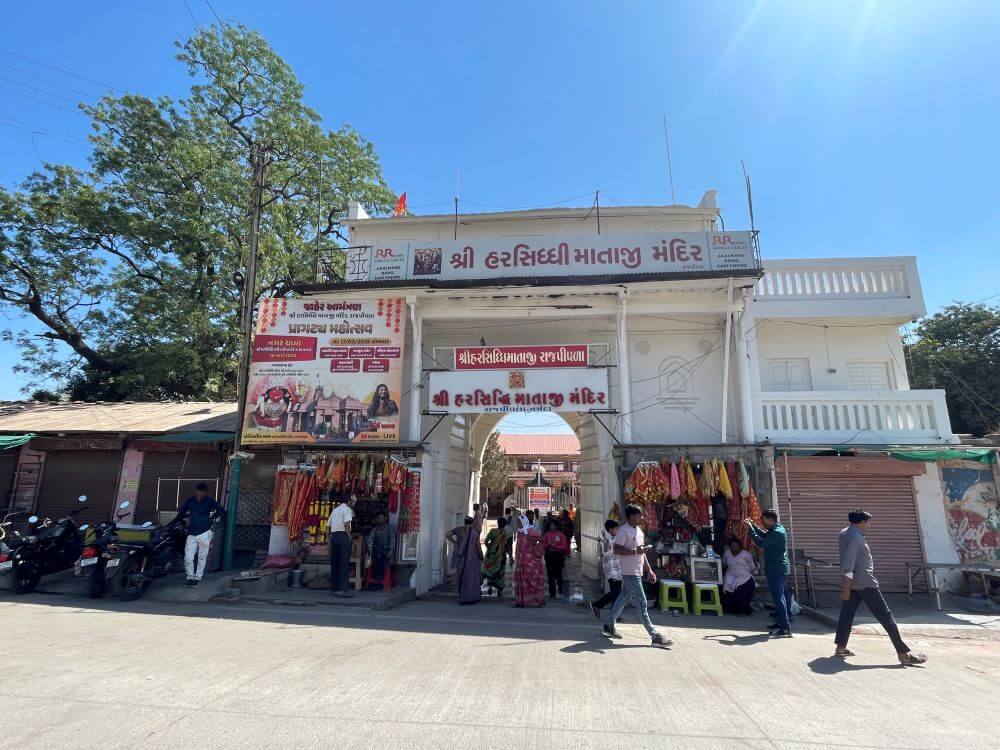 A marble platform in front of the sanctum holds a lion statue. The entrance of the sanctum is adorned with attractive carvings. Inside, the idol of goddess Harsiddhi Mata is installed within an exquisitely carved golden canopy. The deity is richly adorned with garments and ornaments, crowned with a silver tiara, and holds a trident.
A marble platform in front of the sanctum holds a lion statue. The entrance of the sanctum is adorned with attractive carvings. Inside, the idol of goddess Harsiddhi Mata is installed within an exquisitely carved golden canopy. The deity is richly adorned with garments and ornaments, crowned with a silver tiara, and holds a trident.
Annually, about 200,000 devotees visit this revered temple.
Pilgrims fulfill vows by releasing roosters or presenting their newborn children at the temple following the fulfillment of childbirth prayers. Tuesdays and Sundays witness peak visitor numbers, with Navratri celebrations attracting thousands, including royal family members. Cultural festivities, elaborate decorations, and daily Garba dances are highlights. Each day, the goddess is adorned uniquely – riding a tiger on the first day, a lion on the ninth, and an elephant on Dussehra. Rajput youths demonstrate swordsmanship on the sixth day, with royal family participation in rituals on the ninth day.
